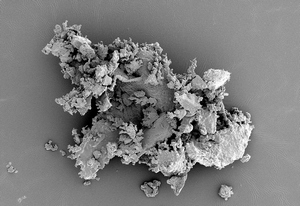Exposure to pet and pest allergens during infancy linked to reduced asthma risk
NIH-funded study may aid development of asthma prevention strategies.
Children exposed to high indoor levels of pet or pest allergens during infancy have a lower risk of developing asthma by 7 years of age, new research supported by the National Institutes of Health reveals. The findings, may provide clues for the design of strategies to prevent asthma from developing.

While previous studies have established that reducing allergen exposure in the home helps control established asthma, the new findings suggest that exposure to certain allergens early in life, before asthma develops, may have a preventive effect. The observations come from the ongoing Urban Environment and Childhood Asthma (URECA—pronounced “Eureka”) study, which is funded by NIH’s National Institute of Allergy and Infectious Diseases (NIAID) through its Inner-City Asthma Consortium.
“We are learning more and more about how the early-life environment can influence the development of certain health conditions,” said NIAID Director Anthony S. Fauci, M.D. “If we can develop strategies to prevent asthma before it develops, we will help alleviate the burden this disease places on millions of people, as well as on their families and communities.”
According to the Centers for Disease Control and Prevention, more than 8 percent of children in the United States currently have asthma, a chronic disease that intermittently inflames and narrows the airways. Asthma can result in missed time from school and work and is a major cause of emergency department visits and hospitalizations.
The URECA study investigates risk factors for asthma among children living in urban areas, where the disease is more prevalent and severe. Since 2005, URECA has enrolled 560 newborns from Baltimore, Boston, New York City and St. Louis at high risk for developing asthma because at least one parent has asthma or allergies. Study investigators have been following the children since birth, and the current research report evaluates the group through 7 years of age.
Among 442 children for whom researchers had enough data to assess asthma status at age 7 years, 130 children (29 percent) had asthma. Higher concentrations of cockroach, mouse and cat allergens present in dust samples collected from the children’s homes during the first three years of life (at age 3 months, 2 years and 3 years) were linked to a lower risk of asthma by age 7 years. The researchers observed a similar association for dog allergen, although it was not statistically significant, meaning it could be due to chance. Additional analysis indicated that exposure to higher levels of these four allergens at age 3 months was associated with a lower risk of developing asthma.
Evidence also suggested that the microbial environment in the home during infancy may be associated with asthma risk. A previous report from URECA that assessed the microbiome of house dust collected in the first year of life suggested that exposure to certain bacteria during infancy may protect 3-year-olds from recurrent wheezing, a risk factor for developing asthma. In the current report, researchers found associations between the abundance of certain types of bacteria in the house dust and an asthma diagnosis by age 7 years, suggesting that exposure to certain types of bacteria in early life might influence development of asthma. However, additional research is needed to clarify the potential roles of these microbial exposures in asthma development.
“Our observations imply that exposure to a broad variety of indoor allergens, bacteria and bacterial products early in life may reduce the risk of developing asthma,” said James E. Gern, M.D., the principal investigator of URECA and a professor at the University of Wisconsin-Madison. “Additional research may help us identify specific targets for asthma prevention strategies.”
In addition, the seven-year URECA results confirm previous research linking development of childhood asthma to recognized risk factors such as prenatal exposure to tobacco smoke and maternal stress and depression. Investigators found that the presence of cotinine, which results from the breakdown of nicotine in the body, in the umbilical cord blood of newborns increased their risk of developing asthma by age 7 years. Maternal stress and depression reported during the first three years of the child’s life also were associated with an increased risk of developing childhood asthma.
The URECA investigators are continuing to monitor the children. By dividing the children into groups based on characteristics of their allergies and asthma, the scientists hope to uncover additional information about which early-life factors influence development of allergic or non-allergic asthma.
Source: U.S. National Institutes of Health
- 387 reads
Human Rights
Ringing FOWPAL’s Peace Bell for the World:Nobel Peace Prize Laureates’ Visions and Actions

Protecting the World’s Cultural Diversity for a Sustainable Future

The Peace Bell Resonates at the 27th Eurasian Economic Summit

Declaration of World Day of the Power of Hope Endorsed by People in 158 Nations

Puppet Show I International Friendship Day 2020

